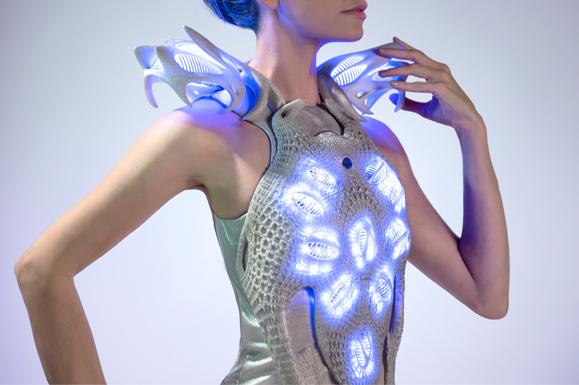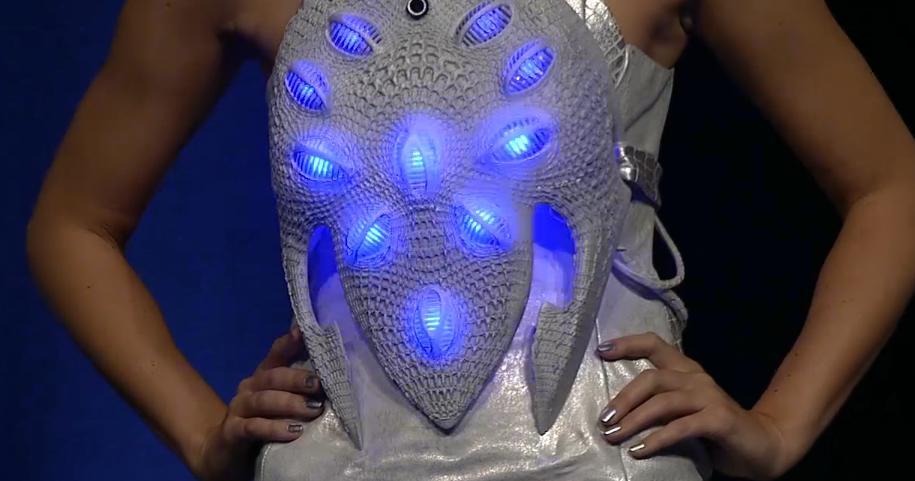 Wearables are becoming quite the fad as of late, and when combined with the up-and-coming technology of 3D printing they are beginning to gain an incredible amount of traction. This increasing interest in wearable devices stems from the culmination of smaller, more powerful computer chips, and the ability to utilize 3D printing technology to create completely custom products. When you add to this equation, the mind and forethought of a fashion designer who has the ability to incorporate engineer-like thinking into her designs, you end up with a product that is both fascinating and futuristic at the same time.
Wearables are becoming quite the fad as of late, and when combined with the up-and-coming technology of 3D printing they are beginning to gain an incredible amount of traction. This increasing interest in wearable devices stems from the culmination of smaller, more powerful computer chips, and the ability to utilize 3D printing technology to create completely custom products. When you add to this equation, the mind and forethought of a fashion designer who has the ability to incorporate engineer-like thinking into her designs, you end up with a product that is both fascinating and futuristic at the same time.
Just a couple weeks ago, we reported on a Dutch designer by the name of Anouk Wipprecht, who had launched a campaign to create the first ever crowdsourced 3D printed dress. The dress, made out of 150 different “elements”, each of which would be customized by a different individual, is slated to be demonstrated at Vienna Fashion Week, this weekend in Austria.
In the mean time, Wipprecht has also been working on creating what could be one of the most fascinating “wearables” that has ever been created. The “Synapse Dress” is a 3D printed garment created by Wipprecht, in collaboration with Niccolo Casas, and Materialise, utilizing the Intel® Edison development platform. We are all used to seeing 3D printed dresses, shoes, and other garments by now. The fascination with these things have subsided quite a bit, as more and more designers have been utilizing the technology to create custom, extravagant clothing, which has mostly only been reserved for runway shows.
The Synapse Dress is to 3D printed clothing, as the modern day iPhone is to Alexander Graham Bell’s first practical telephone. It is unique, eye catching, intuitive, and most incredibly, connected to the wearer’s body. The dress leverages the wearer’s own electrical currents that run through her body, creating an immersive experience unlike no other.
“Connecting raw data driven in real time by wireless bio signals was never before that accessible for me, since the micro controllers that I used were either low in processing power or big and bulky,” explained Wipprecht. “This means – they are hard to integrate into fashion. Edison allows me to integrate a super small piece of technology which can quickly compute complicated sets of signals, on-board storage and interconnect wirelessly to a lot of input data at once in an more advanced and intelligent way, to run my designs.”
The Synapse Dress is 3D printed using Thermoplastic Polyurethane (TPU), which is a very flexible material that provides for a comfort level not all that common within 3D printed garments. Once fitted to a subject, the dress has the ability to pick up different signals from the wearer and the wearer’s body. It is equipped with an EKG, as well as a proximity sensor, a camera, and a series of LED lights capable of 120 watts of brightness. The lights are controlled by a series of different feedback mechanisms and algorithms that are computed, thanks to the Intel® Edison platform.
The dress features multiple modes that can be voice activated, and give the wearer extra sensory capabilities that react to both her physical and social environments. For example, if another subject is to move in too close to the wearer, the proximity camera, the wearer’s heart rate, or her attention level will tell the dress to create a super bright glow which in turn tells the subject to “back off”. The wearer has the ability to engage or disengage people by using these feedback mechanisms.
An on-board camera on the dress is programmed so that when the wearer reaches a level of attention above 80%, it will snap a photograph so that she later can look back and see what was making her feel either extremely tense or very relaxed.
“As the concept of wearable technologies moves from simple tracking devices it may well evolve to represent a more tight alliance between the body, our garments and technology significantly changing how we interface and interact with the world around us. As electronics continue to be figuratively and literally woven into the fabric of our physical world I’m beginning to imagine how these new materials and interactions will impact the way we connect, communicate and relate to one another. Technology therefore becomes transformed from the role of a ‘device’ towards functioning as the medium itself, opening a discussion about where such intimate technologies will lead us.”
What do you think? Will innovations such as the Intel Edison, and new processes of 3D design and printing lead to more intuitive wearables in the future? Discuss in the 3D Printed Synapse Dress forum thread on 3DPB.com.
Check out the video showing the model of the dress below:
Subscribe to Our Email Newsletter
Stay up-to-date on all the latest news from the 3D printing industry and receive information and offers from third party vendors.
You May Also Like
Model No. Deploys Titan Pellet 3D Printers for Sustainable Furniture Production
Over the years, many designers have tried to create 3D printed polymer furniture. Early pioneers like Janne Kyttanen, Materialise’s MGX, and Joris Laarman have led the way with 3D printed...
3D Printing News Unpeeled: Recycling PLA, More Efficient Atomizing
Filamentive hopes to recycle your PLA if you’re in the UK and order over £500 worth of filament. Their partner 3D Printing Waste (3DPW) will turn the PLA into injection...
Lighting the Way with Potato Starch: Sustainable Polish ECO Lamps Use 3D Printing
Lighting that meets the essence of nature: this is the reality brought to life by ECO Lamps, which introduces a fresh perspective to sustainable lighting design using potato starch. These...
3D Printing News Unpeeled: 3D Printed Construction Standard, Sand Wall & Self Heating Microfluidics
ISO/ASTM Standard 52939:2023 has been released and it sets standards for QA for 3D Printed polymer, composite and cement buildings. This is most welcome since 3D printed construction is a...


































